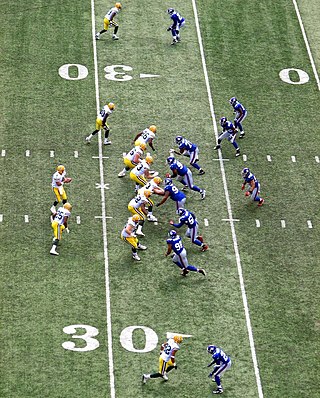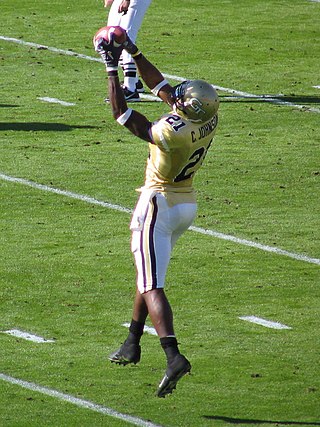
The shotgun formation is a formation used by the offensive team in gridiron football mainly for passing plays, although some teams use it as their base formation. Instead of the quarterback receiving the snap from center at the line of scrimmage, in the shotgun he stands farther back, often five to seven yards off the line. Sometimes the quarterback will have a back on one or both sides before the snap, while other times he will be the lone player in the backfield with everyone spread out as receivers.

A wide receiver (WR), also referred to as a wideout, historically known as a split end (SE) or flanker (FL), is an eligible receiver in gridiron football. A key skill position of the offense, WR gets its name from the player being split out "wide", farthest away from the rest of the offensive formation.
A screen pass is a play in gridiron football consisting of a short pass to a receiver who is protected by a screen of blockers. During a screen pass, a number of things happen concurrently in order to fool the defense into thinking a long pass is being thrown, when in fact the pass is merely a short one, just beyond the defensive linemen. Screens are usually deployed against aggressive defenses that rush the passer. Because screens invite the defense to rush the quarterback, they are designed to leave fewer defensemen behind the rushers to stop the play.
A draw play, or simply draw for short, is a type of American football play. The draw is a running play disguised as a passing play. It is the opposite of a play-action pass, which is a passing play disguised as a running play. The play is often used in long yardage situations.
Strategy forms a major part of American football. Both teams plan many aspects of their plays (offense) and response to plays (defense), such as what formations they take, who they put on the field, and the roles and instructions each player are given. Throughout a game, each team adapts to the other's apparent strengths and weaknesses, trying various approaches to outmaneuver or overpower their opponent in order to win the game.

An option offense is an American football offensive system in which a key player has several "options" of how each play will proceed based upon the actions of the defense. Traditionally, option-based offenses rely on running plays, though most mix in forward passes from an option formation as a change of pace.

In American football, a bootleg play is a play in which the quarterback runs with the ball in the direction of either sideline behind the line of scrimmage. This can be accompanied by a play action, or fake hand off of the ball to a running back running the opposite direction.
The halfback option play is an unorthodox play in American and Canadian football. It resembles a normal running play, but the running back has the option to throw a pass to another eligible receiver before crossing the line of scrimmage.
A trick play, also known as a gadget play, gimmick play or trickeration, is a play in gridiron football that uses deception and unorthodox tactics to fool the opposing team. A trick play is often risky, offering the potential for a large gain or a touchdown if it is successful, but with the chance of a significant loss of yards or a turnover if not. Trick plays are rarely used not only because of the riskiness, but also to maintain the element of surprise for when they are used.

A halfback (HB) is an offensive position in American football, whose duties involve lining up in the offensive backfield and carrying the ball on most rushing plays, i.e. a running back. When the principal ball carrier lines up deep in the backfield, and especially when that player is placed behind another player, as in the I formation, that player is instead referred to as a tailback.

In American football, the specific role that a player takes on the field is referred to as their "position". Under the modern rules of American football, both teams are allowed 11 players on the field at one time and have "unlimited free substitutions", meaning that they may change any number of players during any "dead ball" situation. This has resulted in the development of three task-specific "platoons" of players within any single team: the offense, the defense, and the so-called 'special teams'. Within these three separate "platoons", various positions exist depending on the jobs that the players are doing.

The flexbone formation is an offensive formation in American football that includes a quarterback, five offensive linemen, three running backs, and varying numbers of tight ends and wide receivers. The flexbone formation is a predominant turnover formation derived from the wishbone formation and it features a quarterback under center with a fullback lined up directly behind the quarterback. There are two smaller running backs called slotbacks aligned behind the line of scrimmage on each side of the offensive line. The slotbacks are sometimes incorrectly referred to as wingbacks. But in order to be a wingback, there must be a guard, tackle and tight end all on one side of the center on the line of scrimmage and then the wingback off the line of scrimmage.
The triple option is an American football play used to offer several ways to move the football forward on the field of play. The triple option is based on the option run, but uses three players who might run with the ball instead of the two used in a standard option run.
In American football, a play is a close-to-the-ground plan of action or strategy used to move the ball down the field. A play begins at either the snap from the center or at kickoff. Most commonly, plays occur at the snap during a down. These plays range from basic to very intricate. Football players keep a record of these plays in a playbook.
The following terms are used in American football, both conventional and indoor. Some of these terms are also in use in Canadian football; for a list of terms unique to that code, see Glossary of Canadian football.
Wildcat formation describes a formation for the offense in football in which the ball is snapped not to the quarterback but directly to a player of another position lined up at the quarterback position. The Wildcat features an unbalanced offensive line and looks to the defense like a sweep behind zone blocking. A player moves across the formation prior to the snap. However, once this player crosses the position of the running back who will receive the snap, the play develops unlike the sweep.

Buck-lateral is an American football play or a series of plays used in the Single-wing formation. Since the Single-Wing formation lost prominence by 1950, the football play referred to as the buck-lateral is almost gone from football's vocabulary. However, prior to this time, the buck-lateral play gave fullbacks the option to run, lateral, or hand off the ball to another player. Running the buck-lateral required an offensive scheme that needed the fullback to possess many specialized skills, as opposed to today's fullback who mainly blocks and carries the ball infrequently.
In American football, a smashmouth offense is an offensive system that relies on a strong running game, where most of the plays run by the offense are handoffs to the fullback or tailback. It is a more traditional style of offense that often results in a higher time of possession by running the ball heavily. So-called "smash-mouth football" is often run out of the I-formation or wishbone formation, with tight ends and receivers used as blockers. Though the offense is run-oriented, pass opportunities can develop as defenses play close to the line. Play-action can be very effective for a run-oriented team.
The run and shoot offense is an offensive system for American football which emphasizes receiver motion and on-the-fly adjustments of receivers' routes in response to different defenses. It was conceived by former high school coach Glenn "Tiger" Ellison and refined and popularized by former Portland State offensive coordinator Mouse Davis.








